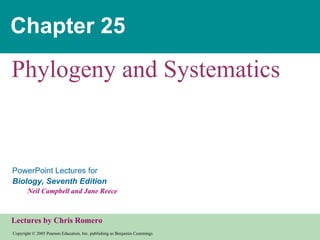Denunciar
Compartir

Más contenido relacionado
La actualidad más candente
La actualidad más candente (20)
Similar a Chapter25
Similar a Chapter25 (20)
Ap Chapter 26 Evolutionary History Of Biological Diversity

Ap Chapter 26 Evolutionary History Of Biological Diversity
Último
+971581248768>> SAFE AND ORIGINAL ABORTION PILLS FOR SALE IN DUBAI AND ABUDHA...

+971581248768>> SAFE AND ORIGINAL ABORTION PILLS FOR SALE IN DUBAI AND ABUDHA...?#DUbAI#??##{{(☎️+971_581248768%)**%*]'#abortion pills for sale in dubai@
Último (20)
Strategies for Landing an Oracle DBA Job as a Fresher

Strategies for Landing an Oracle DBA Job as a Fresher
Cloud Frontiers: A Deep Dive into Serverless Spatial Data and FME

Cloud Frontiers: A Deep Dive into Serverless Spatial Data and FME
Introduction to Multilingual Retrieval Augmented Generation (RAG)

Introduction to Multilingual Retrieval Augmented Generation (RAG)
"I see eyes in my soup": How Delivery Hero implemented the safety system for ...

"I see eyes in my soup": How Delivery Hero implemented the safety system for ...
+971581248768>> SAFE AND ORIGINAL ABORTION PILLS FOR SALE IN DUBAI AND ABUDHA...

+971581248768>> SAFE AND ORIGINAL ABORTION PILLS FOR SALE IN DUBAI AND ABUDHA...
TrustArc Webinar - Unlock the Power of AI-Driven Data Discovery

TrustArc Webinar - Unlock the Power of AI-Driven Data Discovery
Why Teams call analytics are critical to your entire business

Why Teams call analytics are critical to your entire business
Navigating the Deluge_ Dubai Floods and the Resilience of Dubai International...

Navigating the Deluge_ Dubai Floods and the Resilience of Dubai International...
Apidays New York 2024 - Accelerating FinTech Innovation by Vasa Krishnan, Fin...

Apidays New York 2024 - Accelerating FinTech Innovation by Vasa Krishnan, Fin...
AWS Community Day CPH - Three problems of Terraform

AWS Community Day CPH - Three problems of Terraform
Cloud Frontiers: A Deep Dive into Serverless Spatial Data and FME

Cloud Frontiers: A Deep Dive into Serverless Spatial Data and FME
Apidays New York 2024 - The Good, the Bad and the Governed by David O'Neill, ...

Apidays New York 2024 - The Good, the Bad and the Governed by David O'Neill, ...
ProductAnonymous-April2024-WinProductDiscovery-MelissaKlemke

ProductAnonymous-April2024-WinProductDiscovery-MelissaKlemke
ICT role in 21st century education and its challenges

ICT role in 21st century education and its challenges
Finding Java's Hidden Performance Traps @ DevoxxUK 2024

Finding Java's Hidden Performance Traps @ DevoxxUK 2024
Elevate Developer Efficiency & build GenAI Application with Amazon Q

Elevate Developer Efficiency & build GenAI Application with Amazon Q
Strategize a Smooth Tenant-to-tenant Migration and Copilot Takeoff

Strategize a Smooth Tenant-to-tenant Migration and Copilot Takeoff
Connector Corner: Accelerate revenue generation using UiPath API-centric busi...

Connector Corner: Accelerate revenue generation using UiPath API-centric busi...
Chapter25
- 1. Chapter 25 Phylogeny and Systematics
- 41. 4 Continuing the comparison of bases at sites 2, 3, and 4 reveals that each of these possible trees requires a total of four base-change events (marked again by crossbars). Thus, the first four sites in this DNA sequence do not help us identify the most parsimonious tree. 5 After analyzing sites 5 and 6, we find that the first tree requires fewer evolutionary events than the other two trees (two base changes versus four). Note that in these diagrams, we assume that the common ancestor had GG at sites 5 and 6. But even if we started with an AA ancestor, the first tree still would require only two changes, while four changes would be required to make the other hypotheses work. Keep in mind that parsimony only considers the total number of events, not the particular nature of the events (how likely the particular base changes are to occur). 6 At site 7, the three trees also differ in the number of evolutionary events required to explain the DNA data. RESULTS To identify the most parsimonious tree, we total all the base-change events noted in steps 3–6 (don’t forget to include the changes for site 1, on the facing page). We conclude that the first tree is the most parsimonious of these three possible phylogenies. (But now we must complete our search by investigating the 12 other possible trees.) Two base changes Figure 25.15b I II III IV I III II IV I IV II III I II III IV I III II IV I IV II III I II III IV I III II IV I IV II III I II III IV I III II IV I IV II III GG GG AA AA GG AA GG GG AA GG AA GG GG GG GG AA GG AA GG GG GG T G T G T T T T T G G T G T T G G T T T T 10 events 9 events 8 events
